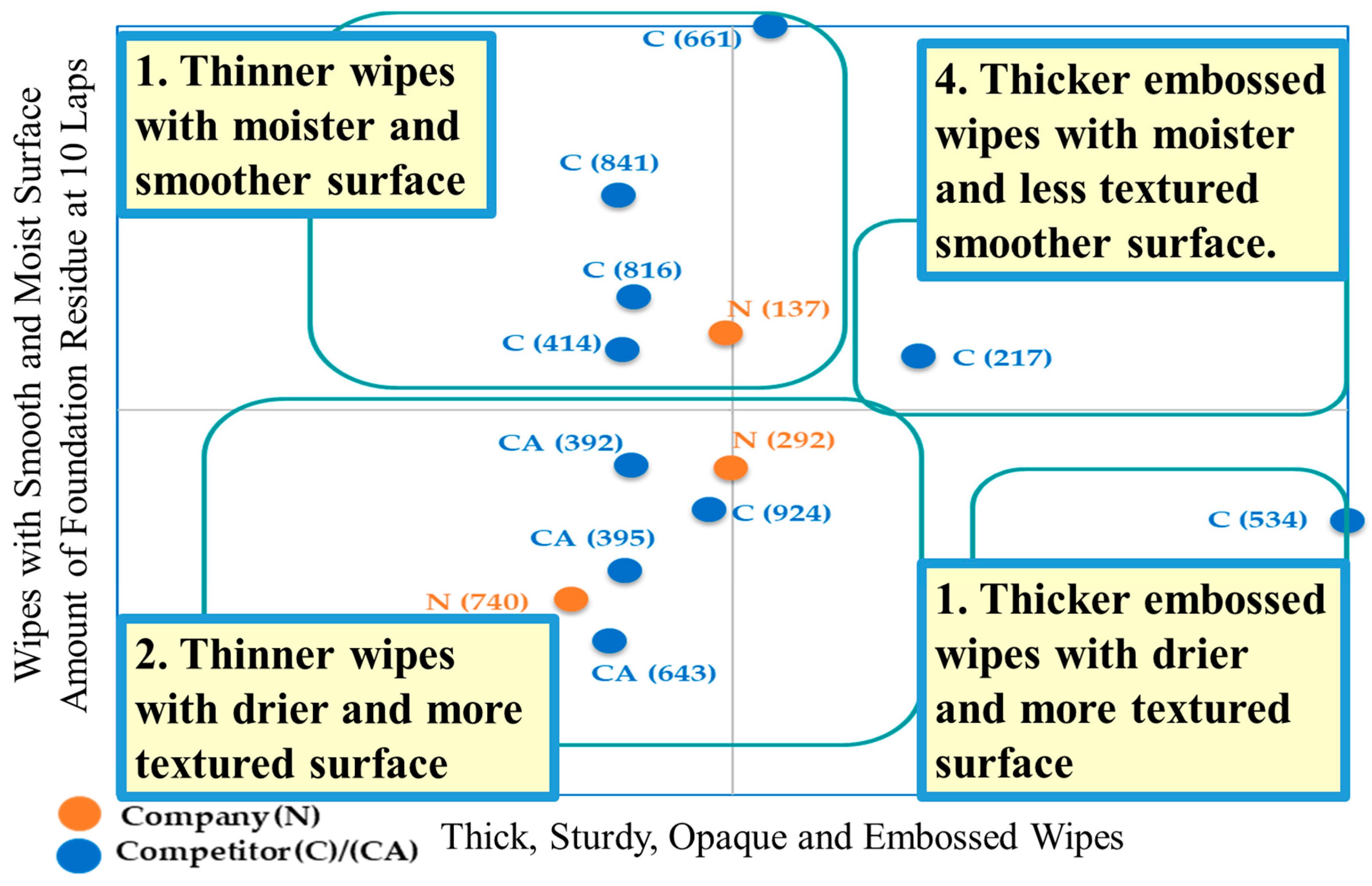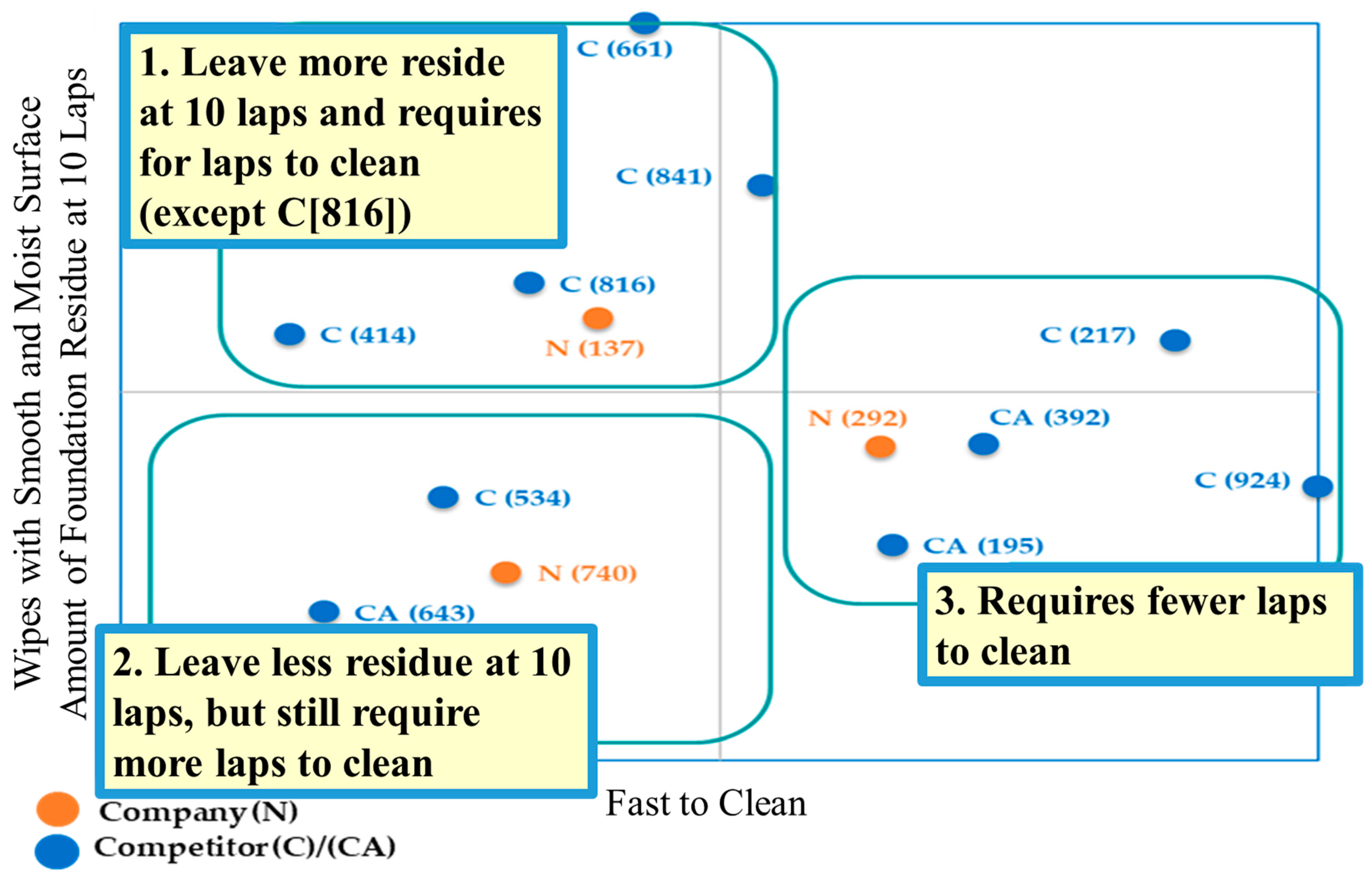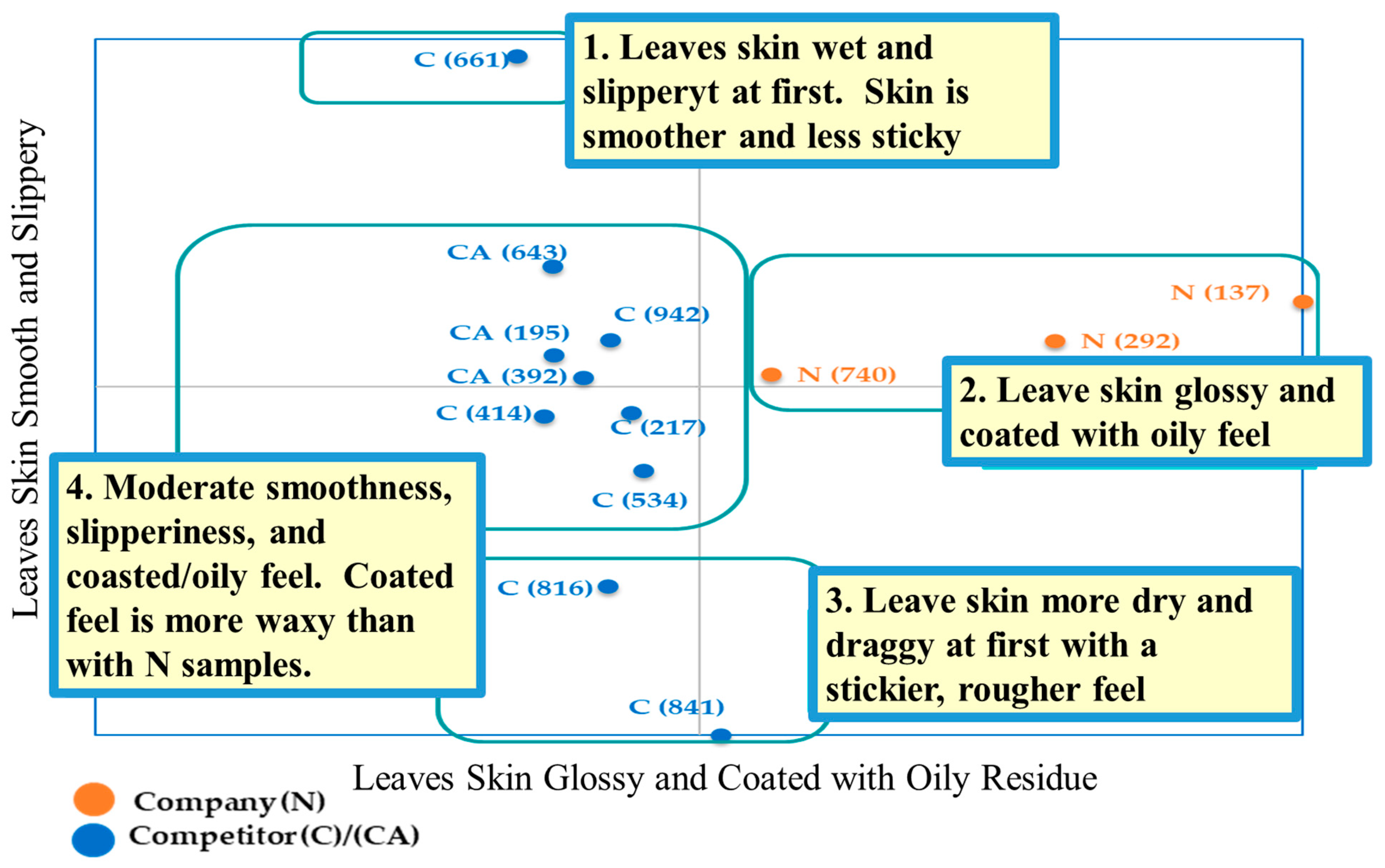Understanding the Global Sensory Landscape for Facial Cleansing/Makeup Remover Wipes
Abstract
:1. Introduction
2. Materials and Methods
2.1. Customized Sensory Descriptive Analysis Method
2.2. Product Evaluation
2.3. Data Analysis
3. Results and Discussion
3.1. Visual and Tactile Properties
3.2. Cleaning Performance Properties
3.3. Skin Perception Properties
3.4. Summary
4. Conclusions
Supplementary Materials
Author Contributions
Funding
Conflicts of Interest
References
- Russell, S.J. Handbook of Nonwovens; Woodhead Publishing Limited: Cambridge, UK, 2007. [Google Scholar]
- Kaplan, S.; Pulan, S.; Ulusoy, S. Objective and subjective performance evaluations of wet wipes including herbal components. J. Ind. Text. 2017, 0, 1–20. [Google Scholar] [CrossRef]
- Meilgaard, M.; Civille, G.V.; Carr, B.T. Sensory Evaluation Techniques, 4th ed.; CRC Pres: Boca Raton, FL, USA, 2007; pp. 161–172. [Google Scholar]
- Campo, E.; Ballester, J.; Langlois, J.; Dacremont, C.; Valentin, D. Comparison of conventional descriptive analysis and a citation frequency-based descriptive method for odor profiling: An application to Burgundy Pinot noir wines. Food Qual. Prefer. 2010, 21, 44–55. [Google Scholar] [CrossRef]
- Cairncross, S.E.; Sjostrom, L.B. Flavor profiles—A new approach to flavor problems. Food Technol. 1950, 4, 308–311. [Google Scholar]
- Szczesniak, A.S. Objective measurements of food texture. J. Food Sci. 1963, 28, 410–420. [Google Scholar] [CrossRef]
- Stone, H.; Sidel, J.; Oliver, S.; Woolsey, A.; Singleto, R.C. Sensory evaluation by quantitative descriptive analysis. Food Technol. 1974, 28, 24–34. [Google Scholar]
- Williams, A.A.; Langron, S.P. The use of free-choice profiling for the evaluation of commercial ports. J. Sci. Food Agric. 1984, 35, 558–568. [Google Scholar] [CrossRef]
- Meilgaard, M.; Civille, G.V.; Carr, B.T. Sensory Evaluation Techniques, 1st ed.; CRC Press: Boca Raton, FL, USA, 1987. [Google Scholar]
- Delarue, J.; Sieffermann, J.M. Sensory mapping using Flash Profile. Comparison with a conventional descriptive method for the evaluation of the flavor of fruit dairy products. Food Qual. Prefer. 2004, 15, 383–392. [Google Scholar] [CrossRef]
- Risvik, E.; McEwan, J.A.; Rødbotten, M. Evaluation of sensory profiling and projective mapping data. Food Qual. Prefer. 1997, 8, 63–71. [Google Scholar] [CrossRef]
- Cadoret, M.; Lê, S. The sorted napping: A new holistic approach in sensory evaluation. J. Sens. Stud. 2010, 25, 637–658. [Google Scholar]
- Worch, T.; Crine, A.; Lê, S. Analysis and validation of the ideal profile method: Application to a skin cream study. Food Qual. Prefer. 2014, 32, 132–144. [Google Scholar] [CrossRef]
- Brard, M.; Lê, S. The ideal pair method, an alternative to the ideal profile method based on pairwise comparisons: Application to a panel of children. J. Sens. Stud. 2016, 31, 306–313. [Google Scholar] [CrossRef]
- Talavera-Bianchi, M.; Chambers, E., IV; Chambers, D. Describing flavor using fewer and simpler ‘HITS’ (high identity traits) profiling: An example with cheese. J. Sens. Stud. 2010, 25, 481–493. [Google Scholar] [CrossRef]
- Civille, G.V.; Dus, C.A. Development of terminology to describe the handfeel properties of paper and fabrics. J. Sens. Stud. 1990, 5, 19–32. [Google Scholar] [CrossRef]
- Bacci, L.; Camilli, F.; Drago, S.; Magli, L.; Vagnoni, E.; Mauro, A.; Predieri, S. Sensory evaluation and instrumental measurements to determine tactile properties of wool fabrics. Text. Res. J. 2012, 82, 1430–1441. [Google Scholar] [CrossRef]
- Sular, V.; Okur, A.E. Sensory evaluation methods for tactile properties of fabrics. J. Sens. Stud. 2007, 22, 1–16. [Google Scholar] [CrossRef]
- Robinson, K.J.; Chambers, E., IV; Gatewood, B.M. Influence of pattern design, color, and fabric type on the hand characteristics of pigmented prints. Text. Res. J. 1997, 67, 837–845. [Google Scholar] [CrossRef]
- Yenket, R.; Chambers, E., IV; Gatewood, B.M. Color has little effect on perception of fabric handfeel tactile properties in cotton fabrics. J. Sens. Stud. 2007, 22, 336–352. [Google Scholar] [CrossRef]
- Lee, I.; Yang, H.; Kim, J.; Maeng, Y.; Lee, C.; Kang, Y.; Rang, M. Terminology development and panel training for sensory evaluation of skin care products including aqua cream. J. Sens. Stud. 2005, 20, 421–433. [Google Scholar] [CrossRef]
- Meilgaard, M.; Civille, G.V.; Carr, B.T. Sensory Evaluation Techniques, 2nd ed.; CRC Press: Boca Raton, FL, USA, 1991. [Google Scholar]
- ASTM. E1490-92 Standard Practice for Descriptive Skinfeel Analysis of Creams and Lotions; ASTM: Barr Harbor, West Conshhocken, PA, USA, 1997. [Google Scholar]



| Baseline Skin-Feel | In-Use Evaluation | After-Feel | Product in Hand | |||
|---|---|---|---|---|---|---|
| After Liquid Foundation Application | After 10 Laps | After Complete Removal | Immediate | 5 Min | ||
| Gloss | Occlusion | Occlusion | # Added Laps to Clean | Gloss | Gloss | Amount of Product |
| − | Amount of Coverage | Amount of Coverage | Evenness of Coverage | Coolness | Coolness | Paper (Fabric) Moistness |
| − | Evenness of Coverage | Coverage Evenness | Residue Amount | Facial Lines | Facial Lines | Hand Moistness |
| − | Amount of Residue | Amount of Residue | Visual Residue | Visual Residue | Gritty | |
| Tautness | Tautness | Tautness | Grainy | |||
| Occlusion | Occlusion | Occlusion | Lumpy | |||
| Stickiness | Stickiness | Stickiness | Fuzzy | |||
| Moistness | Moistness | Moistness | Slipperiness | |||
| Slipperiness | Slipperiness | Slipperiness | Thickness of Wipe | |||
| Roughness | Roughness | Roughness | Force to Gather | |||
| − | Amount of Residue | Amount of Residue | Stiffness | |||
| Soapy Film % | Soapy Film % | Fullness of Body | ||||
| Oil % | Oil % | Depth of Embossing (Macro) | ||||
| Wax % | Wax % | Depth of Embossing (Micro) | ||||
| Grease % | Grease % | Degree of Embossing | ||||
| Silliconey % | Silliconey % | Translucency | ||||
| Powder % | Powder % | Blotchy | ||||
| Particulates (yes = 1, no = 0) | Particulates (yes = 1, no = 0) | |||||
| Company (N) vs. Competitor (C) | Region |
|---|---|
| N (292) | N.A. |
| N (137) | N.A. |
| C (924) | N.A. |
| C (414) | N.A. |
| C (534) | N.A. |
| C (841) | N.A. |
| C (816) | N.A. |
| CA (195) * | EMEA |
| CA (392) * | EMEA |
| C (661) | APAC |
| C (217) | APAC |
| N (740) | LATAM |
| CA (643) * | LATAM |
| Code | Gloss—Baseline | Tautness—Baseline | Occlusion—Baseline | Stickiness—Baseline | Moistness—Baseline | Slipperiness—Baseline | Roughness—Baseline |
|---|---|---|---|---|---|---|---|
| 137 | 11.1 | 15.0 | 0.0 | 0.0 | 5.0 | 80.0 | 20.0 |
| 195 | 11.1 | 15.0 | 0.0 | 0.0 | 5.0 | 80.0 | 20.0 |
| 217 | 11.1 | 15.0 | 0.0 | 0.0 | 5.0 | 80.0 | 20.0 |
| 292 | 11.1 | 15.0 | 0.0 | 0.0 | 5.0 | 80.0 | 20.0 |
| 392 | 10.9 | 15.0 | 0.0 | 0.0 | 5.0 | 80.0 | 20.0 |
| 414 | 11.1 | 15.0 | 0.0 | 0.0 | 5.0 | 80.0 | 20.0 |
| 534 | 11.1 | 15.0 | 0.0 | 0.0 | 5.0 | 80.0 | 20.0 |
| 643 | 11.9 | 15.0 | 0.0 | 0.0 | 5.0 | 80.0 | 20.0 |
| 661 | 11.6 | 15.0 | 0.0 | 0.0 | 5.0 | 80.0 | 20.0 |
| 740 | 11.1 | 15.0 | 0.0 | 0.0 | 5.0 | 80.0 | 20.0 |
| 816 | 11.1 | 15.0 | 0.0 | 0.0 | 5.0 | 80.0 | 20.0 |
| 841 | 11.1 | 15.0 | 0.0 | 0.0 | 5.0 | 80.0 | 20.0 |
| 924 | 11.1 | 15.0 | 0.0 | 0.0 | 5.0 | 80.0 | 20.0 |
| Code | After Application of Foundation | After 10 Laps | After Complete Removal | ||||||||
|---|---|---|---|---|---|---|---|---|---|---|---|
| Occlusion | Amt of Coverage | Even of Coverage—Foundation | Amt of Residue—Foundation | Occlusion—10 Laps | Amt of Coverage—10 Laps | Evenness of Coverage—10 Laps | Amt of Residue—10 Laps | # of Added Laps To Clean | Even of Coverage—After Wiping | Amt of Residue—After Wiping | |
| 137 | 11.6 | 92.4 | 91.4 ab | 78.8 | 6.2 | 7.2 | 5.5 bc | 19.4 AB | 8.1 AB | 0.0 | 0.0 |
| 195 | 13.3 | 92.0 | 92.0 a | 80.4 | 4.6 | 7.1 | 5.4 bc | 15.1 ABCDE | 6.8 ABCD | 0.0 | 0.0 |
| 217 | 12.7 | 91.7 | 91.3 ab | 80.4 | 4.8 | 5.8 | 6.7 bc | 14.7 BCDE | 5.4 CD | 0.0 | 0.0 |
| 292 | 13.1 | 92.2 | 91.3 ab | 77.6 | 4.8 | 6.9 | 5.6 bc | 17.0 ABC | 6.6 ABCD | 0.0 | 0.0 |
| 392 | 18.9 | 91.8 | 91.3 ab | 79.3 | 5.9 | 6.1 | 5.9 bc | 16.0 ABCD | 6.4 BCD | 0.0 | 0.0 |
| 414 | 17.1 | 91.9 | 92.0 a | 80.2 | 4.1 | 8.4 | 6.1 bc | 14.9 ABCDE | 8.3 A | 0.0 | 0.0 |
| 534 | 12.4 | 91.6 | 91.7 ab | 76.3 | 4.3 | 7.3 | 4.8 c | 10.8 E | 7.9 AB | 0.1 | 0.3 |
| 643 | 13.9 | 91.4 | 90.8 b | 79.4 | 6.6 | 9.2 | 9.7 a | 14.7 BCDE | 7.6 AB | 0.1 | 0.1 |
| 661 | 12.7 | 91.5 | 91.4 ab | 79.9 | 4.6 | 8.6 | 6.8 bc | 19.4 AB | 7.3 AB | 0.1 | 0.4 |
| 740 | 12.4 | 90.7 | 89.7 c | 78.2 | 6.2 | 6.2 | 5.9 bc | 13.2 CDE | 8.1 AB | 0.0 | 0.0 |
| 816 | 11.9 | 91.4 | 90.7 bc | 75.9 | 5.2 | 6.2 | 7.2 b | 12.0 DE | 7.7 AB | 0.0 | 0.0 |
| 841 | 13.0 | 91.8 | 91.4 ab | 80.0 | 6.1 | 7.9 | 5.4 bc | 19.7 A | 7.2 ABC | 0.0 | 0.0 |
| 924 | 12.9 | 91.7 | 90.8 b | 81.0 | 5.0 | 7.3 | 6.9 bc | 13.4 CDE | 5.0 D | 0.0 | 0.0 |
| p-value | 0.3250 | 0.3462 | 0.0597 | 0.6402 | 0.2860 | 0.1460 | 0.0844 | 0.0023 | 0.0038 | 0.5745 | 0.5719 |
| LSD | 1.08 | 2.14 | 4.91 | 1.81 | |||||||
| Sig | * | * | ** | ** | |||||||
© 2019 by the authors. Licensee MDPI, Basel, Switzerland. This article is an open access article distributed under the terms and conditions of the Creative Commons Attribution (CC BY) license (http://creativecommons.org/licenses/by/4.0/).
Share and Cite
Xing, H.; Krogmann, A.R.; Vaught, C.; Chambers, E., IV. Understanding the Global Sensory Landscape for Facial Cleansing/Makeup Remover Wipes. Cosmetics 2019, 6, 44. https://doi.org/10.3390/cosmetics6030044
Xing H, Krogmann AR, Vaught C, Chambers E IV. Understanding the Global Sensory Landscape for Facial Cleansing/Makeup Remover Wipes. Cosmetics. 2019; 6(3):44. https://doi.org/10.3390/cosmetics6030044
Chicago/Turabian StyleXing, Huajing, Annlyse R. Krogmann, Claudette Vaught, and Edgar Chambers, IV. 2019. "Understanding the Global Sensory Landscape for Facial Cleansing/Makeup Remover Wipes" Cosmetics 6, no. 3: 44. https://doi.org/10.3390/cosmetics6030044
APA StyleXing, H., Krogmann, A. R., Vaught, C., & Chambers, E., IV. (2019). Understanding the Global Sensory Landscape for Facial Cleansing/Makeup Remover Wipes. Cosmetics, 6(3), 44. https://doi.org/10.3390/cosmetics6030044






